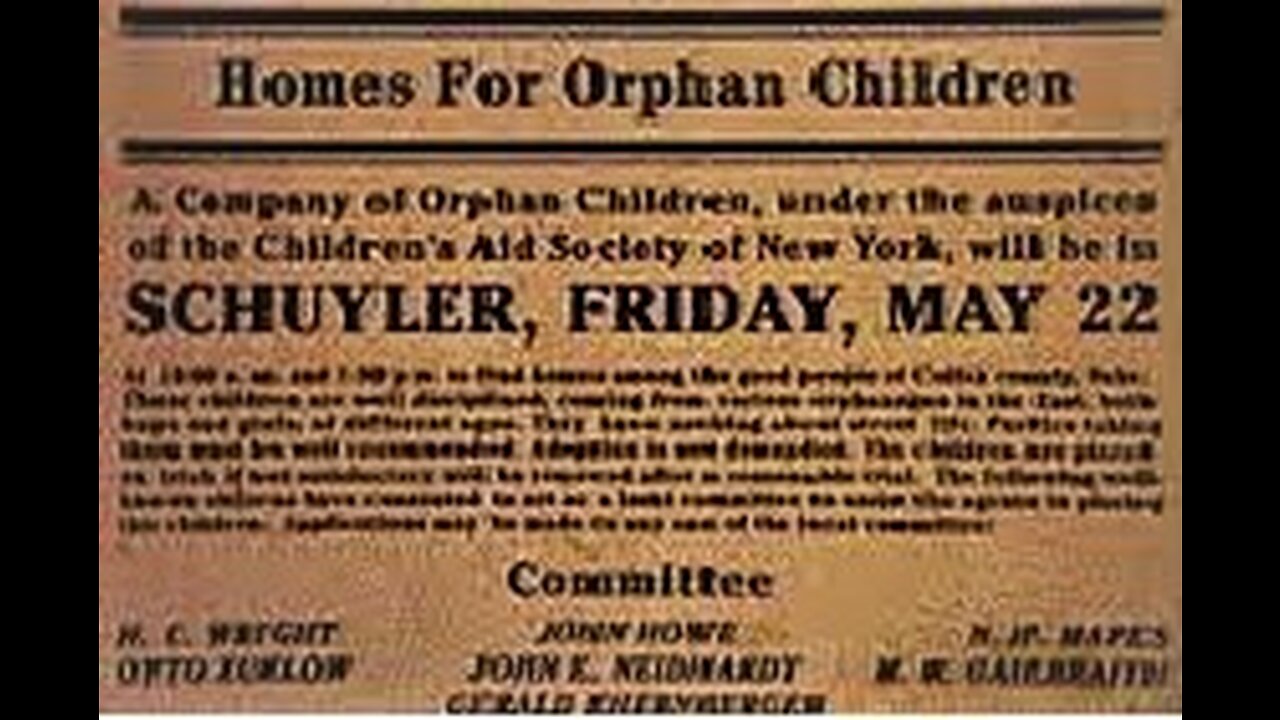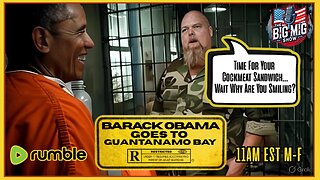Premium Only Content

Satanic, Incubated Orphan Slave Trains Welfare Program
There Were So Many Homeless Orphans In The 1800s They Were Auctioned Off To The Highest Bidder
From the 1850s to the 1920s, orphan trains transported hundreds of thousands of children from the East Coast to the Midwest.
Children who were poor, abandoned, or runaways found themselves traveling across the country to start new lives. The origins of foster care can be tracked back to this unusual practice of shipping kids across the United States to families they never met.
The foster care history timeline beings with Connecticut-born minister Charles Loring Brace. He was alarmed by the abuse and poverty he witnessed among the children of New York City while working as a missionary.
Some kids were housed in overcrowded orphanages, while others were trying to survive on the streets. Many of them were dirty, rambunctious, members of street gangs, and thieves. Their parents were either dead, sick, addicted to drugs and alcohol, or unable to support them for whatever reason. Brace is an important figure in child welfare history in America. Because of him, more than 100,000 children were placed in homes over the course of 75 years. And it all started with orphan trains.
Why Were There So Many Orphans?
Over 4.3 million immigrants moved to the United States between 1841 and 1860. They traveled to America to find a better life and escape their homelands, which were often plagued with political unrest, poverty, and other overwhelming problems.
Some of these immigrants found themselves in overcrowded cities where getting a job was very difficult if not downright impossible. Not the least of their issues, people had a hard time because they didn't have members from their extended family nearby to help raise the children. Everyone pitched in and worked to earn money, including kids as young as six years old.
Desperate men took dangerous jobs and were often killed in their line of work. Women and children were forced to do whatever they could to survive, but it was common for mothers to die at a young age because they lived in filthy homes and contracted typhoid, the flu, or other diseases. Other parents abandoned their children because they had no money or became addicted to drugs and alcohol. As a result, many children wound up as orphans.
There Were As Many As 30,000 Homeless Children In NYC In 1850
Photo: Jacob Riis
The population of New York City in 1850 reached about 500,000 due to the influx of immigrants. Between 10,000 and 30,000 of these residents were homeless kids. Their parents didn't have the means to support them, so they were often forced to strike out on their own. These children either tried to survive on the streets or they lived in orphanages.
If the same percentage of homeless kids lived in New York City today, there would be at least 150,000 orphans without homes.
The First Orphan Train
The Children’s Mission to the Children of the Destitute launched the first orphan train in 1850. The Protestant charity corralled the kids by searching all over the city to locate them. They found them in railway stations, docks, on the streets, and in other areas of the city. The kids were known as "guttersnipes." Thirty kids traveled from Boston to New Hampshire and Vermont to find homes.
Kids Were Auctioned Off To Farmers & Craftsmen Who Needed Them To Work
Children's Aid launched its first orphan train in October of 1854. The train, traveling from New York City to Dowagiac, MI, carried 45 homeless children. When they arrived at their destination, local farmers and craftsmen bid on the kids in an auction.
The families took the children home, where they worked in fields and in other capacities. A total of approximately 250,000 poor and abandoned children were relocated from the East Coast to the Midwest between the 1850s and 1920s.
Some Orphans Were Thieves & Drunks
A man named Joseph Barry was tasked with finding children to put on an orphan train. He found kids who were gambling and - even worse - intoxicated; he came across children as young as eight years old that were drunk. The kids would steal items and trade them with rum sellers in exchange for liquor. Children who should have been in school were instead thieves and alcoholics.
Orphanages Were Overcrowded & Kids Were Kicked Out At Age 14
Between 1820 and 1900, the population in the United States skyrocketed from 9.6 million to 76.1 million. Much of the increase was due to immigrants from Ireland, England, and Germany.
The few orphanages that existed were extremely overcrowded, which is probably why kids were released at the age of 14. These young adults were expected to support themselves with no help from the community.
Orphanages Provided Little Food & Education And Were Bad For Children's Development
By the early 20th century, these orphanages were receiving heavy criticism from the American people, who learned that children's development was adversely affected by the institutions. A UNICEF report titled “Caring for Orphaned, Abandoned and Maltreated Children” noted that all kids, but particularly infants, lacked “eye contact, physical contact and stimulation to promote proper physical, social or cognitive development."
Orphanages were replaced by foster care agencies during the 1920s.
Single Working Mothers Were Often Forced To Use Baby Farms, Which Sold Newborns Or Waited For Them To Die
Most orphanages did not accept infants or young children. Larger cities had foundling hospitals, such as the New York Foundling, which opened in 1869 to save babies who were abandoned on the city's streets.
Single working mothers were often forced to turn to baby farms to care for their newborns. Newborns dropped off at infant institutions often died because they often arrived in poor health with diseases such as scarlet fever, diphtheria, and whooping cough. Foster moms would nurse the infants and either wait for them to die or they would sell them.
Almshouses Turned Children Into Indentured Servants
As the number of immigrants in America continued to grow, cities had increasing difficulty supporting their populations. Almshouses helped provide food and shelter to the less fortunate. However, they struggled to meet the needs of an indigent population and were often mismanaged and corrupt.
Philadelphia almshouses decided to bond out children as a way of making money. Kids and young adults became indentured servants who were supposed to be taught skills and given some education in exchange for their hard labor.
Unfortunately, many abused the system. Some kids were taken from their families without their parents' permission. Children were often placed in areas far away from their families so it would be difficult for them to run away and so parents would not know if their kids were mistreated.
Charles Loring Brace Became The Pioneer Of The Foster Care System
Charles Loring Brace was an ordained minister. He was disturbed by the number of children in New York City whose parents were criminals, alcoholics, and entirely unfit to raise their children. Many of these kids became orphans and turned into what were known as "street Arabs" who joined gangs and committed acts of violence. Some of these children would get arrested and be sent to jail to serve time with adults.
Rev. Brace believed the solution was to place these children with Christian families. In 1854 he transported 46 boys from New York City to Michigan by train accompanied by an agent. Upon arrival, the agent went to a local church and told the community members that the children needed good homes. All of the kids were placed with families within a week.
The Majority Of Placements Were Successful
Between 1855 and 1875, about 3,000 children traveled on the orphan train each year. The kids spent days or even weeks to reach their destinations. Some were excited about being placed with families, while others were upset because they still had parents or other relatives at home.
Most children were placed with families during their trip. People would pick them out at one of the train stops. Families were vetted by local authorities, and Children's Aid would visit them each year to make sure they were doing well. The group removed kids from homes they deemed unfit.
Children's Aid reported in 1910 that 87% of its placements were successful.
Some Kids On The Orphan Train Were More Desirable Than Others
Most orphan trains traveled to the Midwest, which was largely inhabited by Western European immigrants, most of whom were white. Agencies wanted to make the best matches possible by the standards of the time, so the majority of children on the trains were also white.
It was challenging to place non-English speaking children with those who knew their language. Some kids who spoke other languages rode the train several times before finding families who would take them.
The agencies had little problems finding homes for infants, but it was challenging to locate foster families for those over 14 or those who were disabled or sick.
It Wasn't Unusual For Siblings To Be Split Up Among Families
Many children who traveled west on the orphan train were accompanied by their siblings. But they weren't always fostered together. A man named Lee Nailling of Atlanta, TX, recalled being separated from his two brothers. Fortunately, he was able to stay in contact with his siblings. Some orphans, including Nailling, were adopted by their families and treated like biological children.
Children's Aid Provided Free School Lunches, Day Care Centers & More For Those In Need
Charles Loring Brace and others founded Children's Aid in 1853. Up until that point, kids were housed in orphanages or almshouses. The group provided shelter, fresh air programs, and education to approximately 30,000 orphans living in New York City. Children's Aid was the first group to launch the first unofficial free school lunch program in America. In 1881, the organization helped working mothers by opening the first day care for infants and children and in 1906 they began providing free dental care.
The Last Orphan Train
The final orphan train left New York City for Sulphur Springs, TX, on May 31, 1929, during the Great Depression. The economic depression in conjunction with the Dust Bowl devastated families in the Midwest, who couldn't afford to feed themselves much less take in orphans. In addition, the public's perception about orphans changed. Many believed it was better to keep families together. In addition, states began passing laws preventing the placement of children in other states.
The Official Version:
The mid-1850s was a period of rapid "growth" in America
The railroads were pushing west and opening up huge new territories, and millions of people were flocking to this wonderful new land of milk and honey they had heard about back in Europe, lured by the promise of free land and a bright future for themselves and their children.
Many hoped to escape poverty, famines, and political unrest in their homelands.
Between 1841 and 1860, over four million newcomers arrived in America, the largest number of immigrants to any other country in history. While many did find happiness and success, even more found only hardship in their new home. Cities quickly became overcrowded and unable to provide even temporary housing for so many newcomers.
Many found themselves in crowded tenements, often ten or fifteen people crammed into one or two tiny rooms. Few had sanitary facilities, and diseases took a terrible toll.
With the glut of available employees, factory wages plummeted and working conditions were harsh and dangerous. Safety in the workplace was not a priority, and countless men were killed or maimed on the job, leaving behind wives and children who had to survive as best they could. Without extended family to rely upon in times of need, young families fell apart. Children as young as six years old were put to work to help support the family.
Food became scarce and disease was everywhere. Overworked widowed mothers put their children first, working long hours and doing without to feed their children, often leading to early deaths.
Without anyone to take care of them, their children found themselves in orphanages or living on the streets. Many children formed gangs to survive, resorting to criminal activity and even prostitution. The mortality rate was high and nobody seemed to care.
In 1869, the Sisters of Charity had a mission to provide refuge for orphaned and abandoned infants. Working out of a four-story brownstone on East Twelfth Street, sleeping on straw mats on the floor, they established one of the first hospitals in the United States devoted exclusively to foundlings.
The term “foundling” comes from the way these infants were discovered; on the streets, building stoops, and even in the garbage bins of New York City’s slums. Within their first week, they found their first infant, who was left on their doorstep. In just three short weeks, the good Sisters were caring for 45 infants, and that number doubled by the end of their first year. This was the birth of the New York Foundling Hospital.
The New York Foundling Hospital and the Children’s Aid Society developed a program that placed homeless children into homes throughout the country. The children were transported to their new homes on trains, which were eventually labeled “orphan trains.”
Between 1854 and 1929, an estimated 200,000 orphaned, abandoned, and homeless children were placed in homes in forty-seven states and Canada during what is known today as the Orphan Train Movement. When the movement began, it was estimated that 30,000 orphaned and abandoned children were living on the streets of New York City alone.
While Boston and New York were the main sources of the children who were brought into the program, they came from other places, too. Some children were relocated to Canada, and some Canadian homeless children ended up in parts of the western United States.
Placement agents gave local newspapers advance notice of when an Orphan Train would arrive, and families from throughout the region would come to meet the trains. Local volunteers were recruited to screen prospective families, who were asked to care for a new child as if it were their own, providing food, clothing, shelter, and an education.
Many times the newspapers would publish stories about families who took in orphan children, and later run follow-up stories on their progress.
When possible, the New York Foundling Hospital prearranged their placement through local Catholic organizations. Families filled out and submitted request forms, specifying age, sex, eye, and hair color of a child they wanted. The organization tried to match a child with each request. Once selected, the hospital made up two identical tags that had the name of the child, their birth date, if known, the name of their new family, the town and state where they lived, and a number. One tag was sewn into the child’s clothes and one was mailed to the family, making for easier identification at the train depot.
This period of mass relocation of children in the United States is widely recognized as the beginning of documented foster care in America.
The hope was that the children would find loving homes and be assimilated into the families they were placed with, and this happened often.
But not every story had a happy ending. There were more than a few people who viewed the children only as a cheap source of farm labor, and they became little more than indentured servants.
Slavery had ended with the Civil War, but farmers still needed help, and often the children replaced slaves, or sons who were lost in the war.
Sometimes a family would want only one or two children, or children of a certain age, and siblings were torn apart, never to be reunited. Where possible, siblings were placed in the same general area so they could visit occasionally, but many never saw their brothers and sisters again.
Nobody is sure just how many children rode the Orphan Trains over the years, but the best estimates are somewhere between 100,000 and 200,000. Many records, if they exist at all, are hard to find and often confusing. Many people in that time period were immigrants who did not speak English or who were illiterate, and several different organizations were involved in the Orphan Train program over a long period of time.
The quality of record keeping depended on whoever any organization had available at any give time. In many cases there was no birth certificate for a child, or maybe only a certificate of baptism. Many times, a baby was placed in the care of an orphanage or organization without its parents ever being seen.
The National Orphan Train Complex in Concordia, Kansas was established to tell the stories of the children who rode the Orphan Trains, to preserve the history of the movement, and to serve as a research facility for the families of those children.
The complex includes the old Concordia Railroad Depot, which now houses the Orphan Train Museum. Inside are displays on the Orphan Trains and the children who rode them to their new lives. There are many photographs of the children, along with short biographies that tell their stories.
Many are poignant, as is the story of Agnes Stanley Schenk David, who was born at Saint Ann’s Hospital in New York in February, 1901, to a single mother who bowed to social mores and placed her baby with the New York Foundling Hospital. When Agnes was five she was taken by ship to Galveston, Texas, a trip that took several weeks. During the trip, Agnes and the other children were kept in a single cabin, with the windows covered so they could not see out. Agnes was first placed in the home of a German couple in Weimer, Texas, who could not speak English and quickly decided that they didn’t want her. Before the first day was out, she was placed in a horse-drawn buggy and dropped off at the Catholic church in Weimer. Eventually she was taken in by Franz and Annie Schenk, although her new foster mother did not want the child and made it no secret that Agnes would never be a real part of the family.
Jean Sexton had a much happier story to tell. Orphaned at age three, she and her brothers and sister rode the Orphan Train to the Midwest, where Jean was adopted by a childless couple named Walter and Margaret Landreth, who lived a few miles outside of Neosho, Missouri. Jean recalled being very loved and living an idyllic childhood, riding her bicycle, helping her father on the farm, and being a tomboy. Four years later, the Landreth’s took in a niece who had been orphaned, who was only six months younger than Jean, and they grew up as sisters. When she was sixteen, Jean was able to make contact with one of her brothers, who lived in Colorado. They soon found their sister and baby brother, who had been adopted by a family in Auburn, Nebraska. The siblings had a reunion and stayed a part of each others’ lives from that point on.
There are many such stories in the Orphan Train Museum, and even more on the Orphan Train Complex website at www.orphantraindepot.org.
While some saw the Orphan Train program as cruel, there were few alternatives. Welfare and laws to protect children did not exist, and children had no rights. One positive result of the Orphan Train movement was the establishment of the laws we have today to protect children.
Almost all of the children thought that they rode the only orphan train. In their limited child’s world, they could not conceive of there being so many other trains carrying so many other children. Only after the riders started getting together at reunions, and started comparing notes, did they realize just how many children were involved.
They found out that they were not the only ones. There were others out there facing the same kinds of problems that they had faced. They were no longer alone.
Besides the museum, the Orphan Train Complex operates a small gift shop and research library in Concordia. Located at 300 Washington Street, the facility is handicapped accessible and is open Tuesday – Friday from 10 AM to noon, and from 1 to 4 PM. Saturday hours are from 10 AM to 4 PM. They are closed on Sunday, Monday and all national holidays. Admission is $7 for adults, $6 for military, and $4 age 4 to 18. Children 3 and under are free. There is limited parking at the museum for large RVs, but Airport City Park on the south side of town has paved pull-through RV sites with 30/50 amp electric, water, and a dump station. There is no set fee, but there are envelopes and a drop box for donations.
The children who rode the Orphan Train were survivors. In spite of their origins, most of them grew up to became solid citizens from all walks of life. There have been governors, doctors, lawyers, businessmen, teachers, laborers, soldiers and farmers among them. Most of them became loving parents who took in orphans of their own. It has been estimated that there are over two million descendants of Orphan Train riders, and they all share a common heritage, no matter where their parents and grandparents started life.
-
 UPCOMING
UPCOMING
The Shannon Joy Show
1 hour ago🔥🔥While Headlines Scream About Epstein, Obama, Hillary Scandals - Trump’s Digital Leviathan Is Unleashed With The BBB, AI.GOV & Three New Executive Orders🔥🔥
105 -
 1:00:02
1:00:02
VINCE
3 hours agoAre The Walls Closing In On Obama? (w/ Victor Davis Hanson) | Episode 92 - 07/24/25
154K108 -
 LIVE
LIVE
LFA TV
14 hours agoLFA TV ALL DAY STREAM - THURSDAY 7/24/25
4,994 watching -
 LIVE
LIVE
Bannons War Room
5 months agoWarRoom Live
16,229 watching -
 LIVE
LIVE
The Big Mig™
3 hours agoBarack Obama Goes To GITMO
5,497 watching -
 LIVE
LIVE
Badlands Media
8 hours agoBadlands Daily: July 24, 2025
5,334 watching -
 1:09:41
1:09:41
Dear America
3 hours agoBOMBSHELL!! Hillary Was on Tranquilizers!! AND The Clintons Are Being Subpoenaed Over Epstein!!
129K73 -
 LIVE
LIVE
Benny Johnson
2 hours ago🚨US House Votes to SUBPOENA Bill and Hillary Clinton Over Epstein | DOJ Meeting Maxwell Right NOW
7,125 watching -
 2:04:21
2:04:21
Matt Kohrs
11 hours agoStocks Push New Highs, Breaking Market News & Live Trading $1M w/ AI
22.9K -
 LIVE
LIVE
Wendy Bell Radio
8 hours agoNo One Is Above The Law
8,425 watching